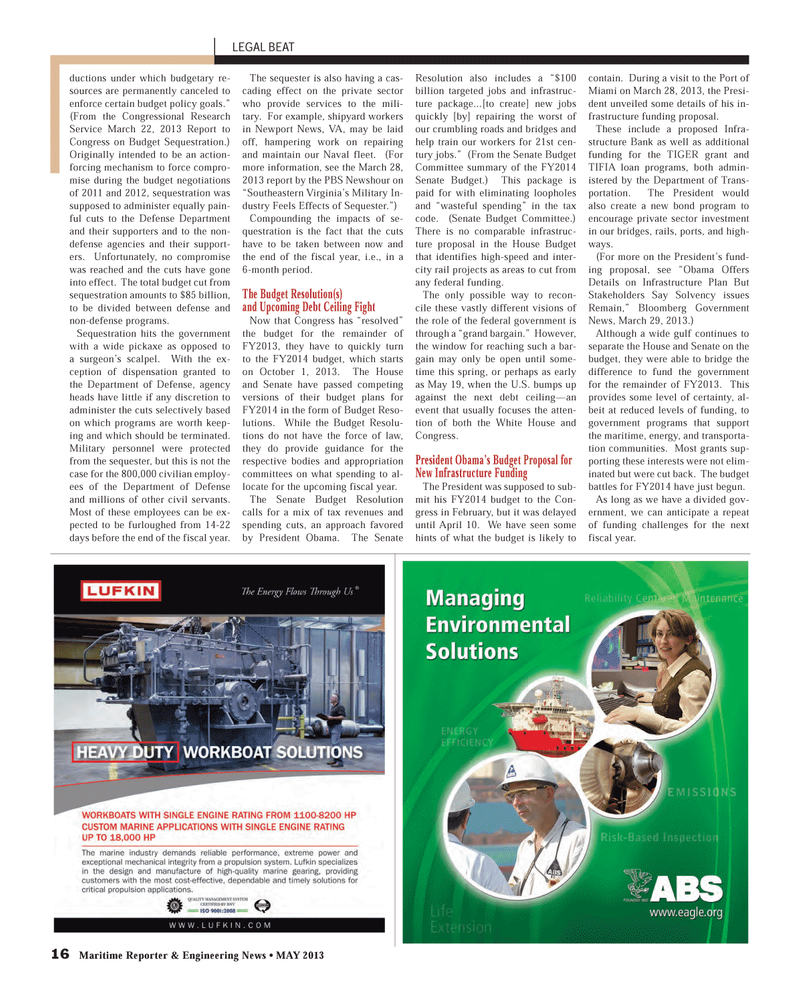
Page 16: of Maritime Reporter Magazine (May 2013)
Energy Production & Transportation
Read this page in Pdf, Flash or Html5 edition of May 2013 Maritime Reporter Magazine
16 Maritime Reporter & Engineering News ? MAY 2013 LEGAL BEAT ductions under which budgetary re-sources are permanently canceled to enforce certain budget policy goals.? (From the Congressional Research Service March 22, 2013 Report to Congress on Budget Sequestration.) Originally intended to be an action-forcing mechanism to force compro-mise during the budget negotiations of 2011 and 2012, sequestration was supposed to administer equally pain-ful cuts to the Defense Department and their supporters and to the non-defense agencies and their support-ers. Unfortunately, no compromise was reached and the cuts have gone into effect. The total budget cut from sequestration amounts to $85 billion, to be divided between defense and non-defense programs. Sequestration hits the government with a wide pickaxe as opposed to a surgeon?s scalpel. With the ex- ception of dispensation granted to the Department of Defense, agency heads have little if any discretion to administer the cuts selectively based on which programs are worth keep-ing and which should be terminated. Military personnel were protected from the sequester, but this is not the case for the 800,000 civilian employ-ees of the Department of Defense and millions of other civil servants. Most of these employees can be ex-pected to be furloughed from 14-22 days before the end of the fiscal year. The sequester is also having a cas-cading effect on the private sector who provide services to the mili-tary. For example, shipyard workers in Newport News, VA, may be laid off, hampering work on repairing and maintain our Naval fleet. (For more information, see the March 28, 2013 report by the PBS Newshour on ?Southeastern Virginia?s Military In- dustry Feels Effects of Sequester.?) Compounding the impacts of se-questration is the fact that the cuts have to be taken between now and the end of the fiscal year, i.e., in a 6-month period. The Budget Resolution(s) and Upcoming Debt Ceiling Fight Now that Congress has ?resolved? the budget for the remainder of FY2013, they have to quickly turn to the FY2014 budget, which starts on October 1, 2013. The House and Senate have passed competing versions of their budget plans for FY2014 in the form of Budget Reso-lutions. While the Budget Resolu- tions do not have the force of law, they do provide guidance for the respective bodies and appropriation committees on what spending to al-locate for the upcoming fiscal year. The Senate Budget Resolution calls for a mix of tax revenues and spending cuts, an approach favored by President Obama. The Senate Resolution also includes a ?$100 billion targeted jobs and infrastruc- ture package...[to create] new jobs quickly [by] repairing the worst of our crumbling roads and bridges and help train our workers for 21st cen-tury jobs.? (From the Senate Budget Committee summary of the FY2014 Senate Budget.) This package is paid for with eliminating loopholes and ?wasteful spending? in the tax code. (Senate Budget Committee.) There is no comparable infrastruc-ture proposal in the House Budget that identifies high-speed and inter- city rail projects as areas to cut from any federal funding. The only possible way to recon-cile these vastly different visions of the role of the federal government is through a ?grand bargain.? However, the window for reaching such a bar- gain may only be open until some-time this spring, or perhaps as early as May 19, when the U.S. bumps up against the next debt ceiling?an event that usually focuses the atten-tion of both the White House and Congress. President Obama?s Budget Proposal for New Infrastructure Funding The President was supposed to sub-mit his FY2014 budget to the Con-gress in February, but it was delayed until April 10. We have seen some hints of what the budget is likely to contain. During a visit to the Port of Miami on March 28, 2013, the Presi-dent unveiled some details of his in-frastructure funding proposal. These include a proposed Infra-structure Bank as well as additional funding for the TIGER grant and TIFIA loan programs, both admin- istered by the Department of Trans- portation. The President would also create a new bond program to encourage private sector investment in our bridges, rails, ports, and high-ways. (For more on the President?s fund- ing proposal, see ?Obama Offers Details on Infrastructure Plan But Stakeholders Say Solvency issues Remain,? Bloomberg Government News, March 29, 2013.) Although a wide gulf continues to separate the House and Senate on the budget, they were able to bridge the difference to fund the government for the remainder of FY2013. This provides some level of certainty, al- beit at reduced levels of funding, to government programs that support the maritime, energy, and transporta- tion communities. Most grants sup-porting these interests were not elim-inated but were cut back. The budget battles for FY2014 have just begun. As long as we have a divided gov-ernment, we can anticipate a repeat of funding challenges for the next fiscal year. MR #5 (10-17).indd 16MR #5 (10-17).indd 165/6/2013 3:02:29 PM5/6/2013 3:02:29 PM

 15
15

 17
17
